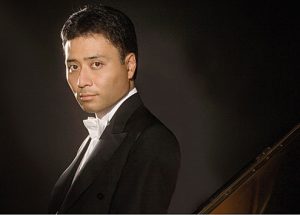By Josef Sekon, D.M.A.

The Copland work demonstrated the first of two huge influences Maestro Stewart has had in developing the orchestra: the correct and “artistic” realization of the written score. Copeland’s Fanfare was flawlessly performed by a brass choir of eleven members: 4 Horns, 3 trumpets, 3 trombones and tuba. The calculated result was ultra – perfection of the highest musical order!
The point, counter point of Copland’s all brass work against Briseno’s all string work, deserves a well done! The pleasant surprise of the afternoon was Briseno’s El Sinaloense. Without doubt, were the theatre doors open, the audience would have been dancing in the streets! During the Friday rehearsal, the Maestro reiterated several times the importance of bringing forth subtle nuances and dynamic importance found in the up-beat syncopations of mariachi performance. These challenges were met head on with virtuosity by bassists Aleksey Klyushnik and Kelly Beecher and cellist Sheng Zhang, whose performances were most outstanding!
Jon Nakamatsu demonstrated that he is at ease performing Gershwin, as he is Mozart. Always in perfect dynamic balance with the orchestra and always ready to display his awesome virtuosity and musicianship. Nakamatsu’s fluid runs, hand crossings and chordal entrances were spot on throughout. The cadenzas were especially inventive!
The somber opening of the Dvorak was the calm before the dynamic tutti that ignited this beautiful performance. Each of the four movements offered a special musical feeling that overwhelmed the audience to the point of applauding at the end that in turn was acknowledged by Maestro Stewart. The English horn solo performed by Michael Adduci depicting the forest funeral of Minnehaha in the second movement was simply wonderful. Throughout the four movements there were similar moments of horn, flute, brass and percussion performance that were musically impressive and complete in bringing forth a memorable musical experience. Stewart brought textural clarity to the work, enhanced by the exceptionally subtle dialogue between orchestral families. Most noteworthy were several designated phrase endings that slowly, calmly vanished into nothingness. Very well done!
Our sister orchestra in San Francisco needs to take heed that just to the South another orchestra is creating magically beautiful music that is fast creating an equal reputation!